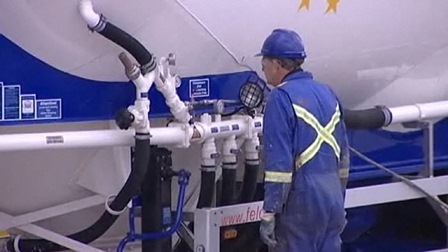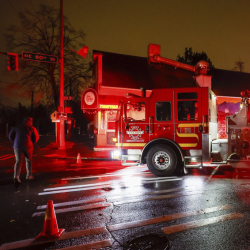 (CNN) -- The use of hydraulic fracturing to open underground natural gas formations has a low risk of triggering earthquakes, federal experts reported Friday, but some scientists say the debate is far from over.
(CNN) -- The use of hydraulic fracturing to open underground natural gas formations has a low risk of triggering earthquakes, federal experts reported Friday, but some scientists say the debate is far from over.
"Fracking," as the process is commonly known, involves injecting a mixture of water and chemicals deep into the Earth. The pressure causes shale rock formations to fracture, and natural gas is released. The fluid is extracted, and the natural gas is mined through the well.
There's a higher risk of man-made seismic events when wastewater from the fracking process is injected back into the ground, according to a report by the National Research Council, an arm of the National Academy of Sciences. But out of about 30,000 disposal wells nationwide, only a handful of noticeable tremors have been reported, with the strongest equivalent to a magnitude-4.8 earthquake, the panel of engineers and scientists concluded.
Congress requested the study in 2010, as hydraulic fracturing triggered a natural gas production boom that has driven down the price of the fuel by 45% in the past year. Although the boom has fattened landowners' wallets, it has been accompanied by concerns that the practice can harm the environment by contaminating groundwater -- and by triggering quakes.
In the region surrounding Youngstown in northeastern Ohio, where the boom is in full swing, seismic instruments recorded nearly a dozen small quakes in 2011, with a magnitude-4.0 tremor reported December 31.
John Armbruster of Columbia University, who's been studying seismic events and fracking in the Youngstown area for months, said Friday that it's "virtually certain" that an injection of fracking wastewater caused the New Year's Eve tremor.
Depending on its location, "any disposal well that's been pumping stuff into the ground for months can cause earthquakes," said Armbruster, who's studied earthquakes and drilling for 40 years.
The quakes prompted state officials in January to order four fluid injection wells in the eastern part of the state to be "indefinitely" prohibited from opening.
Small quakes also have been reported in Oklahoma, Colorado and Arkansas, and "these events are being examined for potential links to injection," Friday's report states.
"Hydraulic fracturing in a well for shale gas development, which involves injection of fluids to fracture the shale and release the gas up the well, has been confirmed as the cause for small felt seismic events at one location in the world," the report states. It found small seismic events involving "a very limited number" of injection wells, but the long-term effects of the growing number of wells wasn't known.
In general, shifting the balance of fluids underground -- whether taking more out of the ground than is put back in or vice versa -- is likely to trigger seismic activity, the report concludes.
"While the general mechanisms that create induced seismic events are well understood, we are currently unable to accurately predict the magnitude or occurrence of such events due to the lack of comprehensive data on complex natural rock systems and the lack of validated predictive models," it states.
"I don't think it's realistic that this treasure will be sitting underneath us and we won't use it," Armbruster said. "It needs to be heavily regulated." Compared with fracking's money-making potential, he says, "monitoring these wells doesn't cost a lot of money."
The highest potential for man-made quakes may come from the development of carbon-capture technology, an effort to recover the carbon dioxide released by fossil fuels and blamed for an increase in global temperatures. But the report says more study is needed, since no since no large-scale carbon-capture projects are running at this point.
The U.S. Geological Survey, the federal outfit that studies earthquakes, acknowledges that increased seismic activity coincides with wastewater injection. But it does not say there's proof of a direct connection.
"While it appears likely that the observed seismicity rate changes in the middle part of the United States in recent years are manmade, it remains to be determined if they are related to either changes in production methodologies or to the rate of oil and gas production," wrote David J. Hayes, deputy secretary of the U.S. Department of the Interior, which oversees the USGS.
"That's too weak," Armbruster said. "In the case of Youngstown, the chance that this is just a random coincidence is like winning the lottery. It's a million to one that it's just a random coincidence."
Analysts say fracking has great potential as a "geopolitical game-changer." They say a domestic gas windfall could cut U.S. reliance on imports from energy-rich "rogue" nations.
Health and safety questions surrounding hydraulic fracturing have spurred battles in several states between neighbors and between farmers and environmentalists. In New York, the governor appointed a panel to investigate allegations that fracking may contaminate underground drinking water.
New York City gets roughly half its water from the Delaware River Basin, a key area for hydraulic fracturing.
Both the Upper Delaware and Monongahela rivers sit on an area called the Marcellus Shale, which lies beneath large parts of Pennsylvania, New York and West Virginia at a depth of 5,000 to 8,000 feet, according to the Pennsylvania Department of Environmental Protection.
The shale is believed to hold trillions of cubic feet of natural gas. Before technological advances in hydraulic fracturing, the natural gas in the region had been considered too expensive for access.
Portland and Seattle
Free Subscription to Breaking News
Free Subscription to Breaking News






















































































































































































































































































































































